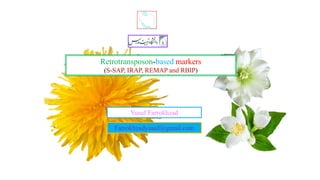
Transposable elements
- 1. Retrotransposon-based markers (S-SAP, IRAP, REMAP and RBIP) Farrokhzadyusuf@gmail.com Yusuf Farrokhzad 1/28/2018 1
- 2. In 1940s Barbara McClintock did a series of genetic experiments with corn that led her to hypothesize the existence of what she called the “controlling genes” which modify or suppress gene activity and are mobile in the genome (1950). A Brief History: Barbara Mc Clintock 1902 -1992 ( noble in 1984) She spent the three decades for this genetic elements. 1/28/2018 2
- 3. We now know that only 1.1% to 1.4% of our DNA actually encodes proteins. More than 50% of our genome consists of short, repeated sequences, the vast majority of which—about 45% of our genome in all—come from transposons. High proportion of species genome: 10% of several fish species 12 % of the Caenorhabditis. elegans genome 37% of the mouse genome 45% human genome up to >80% - some plants like maize 1/28/2018 3
- 4. 1. Transposon: a DNA sequence with the ability to move and be inserted at a new location of the genome. 2. Retrotransposon :a mobile DNA sequence that can insert itself at a different position by using reverse transcriptase. Normal ubiquitous components of the genomes Jumping genes Selfish DNAs Molecular parasites Controlling elements They can cause genome rearrangement (mutation, deletion and insertion). They have wide range of application potentials They are the major forces driving evolution 1/28/2018 4
- 5. More details: More abundant in eukaryotic genomes than prokaryotes Transposons are a major source of genetic variation. This lends the genome flexibility to adapt to changing environmental conditions during the course of evolution. Although the precision of the genetic information depends on stability, complete stability would also mean static persistence. This would be detrimental to the development of new forms of life. Genomes are subject to alterations, as life requires a balance between the old and the new. 1/28/2018 5
- 6. Classification of Transposable Elements Transposons can be divided into the following three families on the basis of their overall organization and mechanism of transposition. 1) DNA transposons: Encodes proteins that moves the DNA element directly to a new position or replicate the DNA to produce a new element that integrates elsewhere in the genome (both prokaryotes and eukaryotes). 2)Virus-like retrotransposons: These elements are also called long terminal repeat (LTR) retrotransposons. Encodes a reverse transcriptase for making DNA copies of their RNA transcripts which subsequently integrates at new sites in the genome (only prokaryotes) 3) Poly-A retrotransposons: These elements are also called non-viral retrotransposons. The element terminates in the 5’ and 3’ untranslated region (UTR) sequences and encodes two enzymes: an RNA-binding enzyme (ORF1) and an enzyme having both reverse transcriptase and endonuclease activities (ORF2). 1/28/2018 6
- 7. 1/28/2018 7
- 8. Plant genomes are rich in transposons: Maize color varigation due to chromosome breakage by transposition Snapdragons: size of white patches related to frequency of transposition
- 9. The cut-and-paste mechanism of transposition. Movement of a transposon from a target site in the host DNA to a new site in the DNA. 1/28/2018 9
- 10. 1/28/2018 10
- 11. o Retrotransposon Because retrotransposon insertions are irreversible, they are considered particularly useful in phylogenetic studies. In addition, their widespread occurrence throughout the genome can be exploited in gene mapping studies, and they are frequently observed in regions adjacent to known plant genes. o Inter-Retrotransposon amplified polymorphism (IRAP): o Sequence-specific amplification polymorphism (S-SAP): o Retrotransposon-microsatellites amplification polymorphism (REMAP): o Retrotransposon-based amplification polymorphism (RBIP): 1/28/2018 11
- 12. o Sequence-specific amplification polymorphism (S-SAP): Sequence-Specific Amplified Polymorphism (S-SAP) is a dominant, multiplex marker system for the detection of variation in DNA flanking the retrotransposon insertion site. Retrotransposon containing fragments are amplified by PCR, using one primer designed from the conserved terminus of the LTR and one based on the presence of a nearby restriction endonuclease site. Experimental procedures resemble those used for AFLP analysis and they are usually dominant markers. Compared to AFLP, S-SAP generally yields fewer fragments but higher levels of polymorphism. 1/28/2018 12
- 13. 1/28/2018 13
- 14. Inter-Retrotransposon Amplified Polymorphism (IRAP) are dominant, multiplex marker systems that examine variation in retrotransposon insertion sites. o Inter-Retrotransposon amplified polymorphism (IRAP): With IRAP, fragments between two retrotransposons are isolated by PCR, using outward- facing primers annealing to LTR target sequences. IRAP as well as REMAP fragments can be separated by high-resolution agarose gel electrophoresis. 1/28/2018 14
- 15. o Retrotransposon-microsatellites amplification polymorphism (REMAP): Retrotransposon-Microsatellite Amplified Polymorphism (REMAP) are dominant, multiplex marker systems that examine variation in retrotransposon insertion sites. In the case of REMAP, fragments between retrotransposons and microsatellites are amplified by PCR, using one primer based on a LTR target sequence and one based on a simple sequence repeat motif. IRAP and REMAP fragments can be separated by high-resolution agarose gel electrophoresis. 1/28/2018 15
- 16. 1/28/2018 16
- 17. Retrotransposon-Based Insertional Polymorphism (RBIP) is a codominant marker system that uses PCR primers designed from the retrotransposon and its flanking DNA to examine insertional polymorphisms for individual retrotransposons. o Retrotransposon-based amplification polymorphism (RBIP): Presence or absence of insertion is investigated by two PCRs, the first using one primer from the retrotransposon and one from the flanking DNA, the second using primers designed from both flanking regions. Polymorphisms are detected by simple agarose gel electrophoresis or by dot hybridization assays. A drawback of the method is that sequence data of the flanking regions is required for primer design. 1/28/2018 17
- 18. 1/28/2018 18
- 19. 1/28/2018 19
- 20. 1/28/2018 20
- 21. 1/28/2018 21
